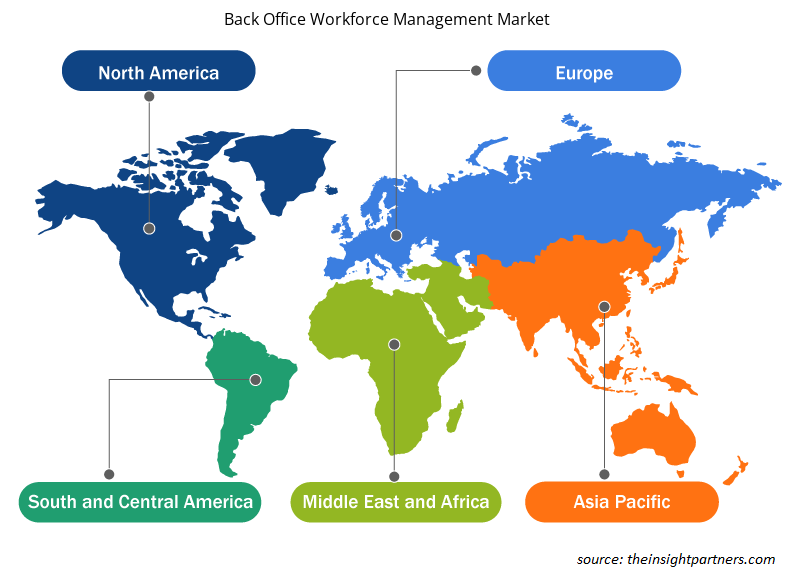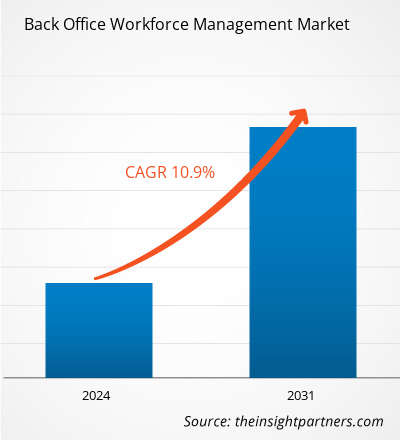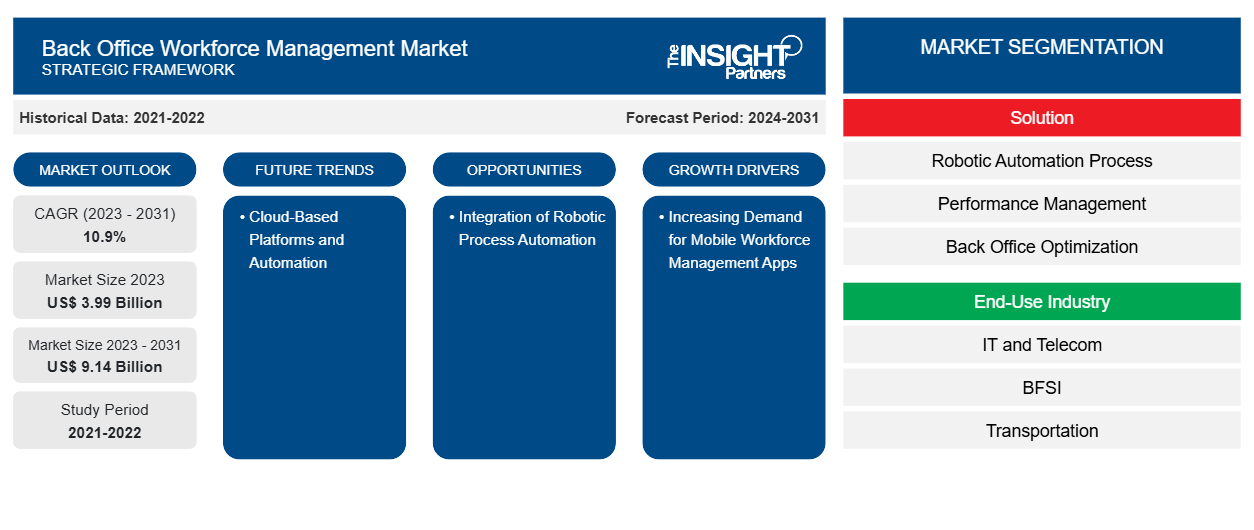Le marché de la gestion des effectifs du back-office devrait atteindre 9,14 milliards de dollars d'ici 2031, contre 3,99 milliards de dollars en 2023. Le marché devrait enregistrer un TCAC de 10,9 % au cours de la période 2023-2031. Les plateformes basées sur le cloud et l'automatisation devraient rester une tendance clé du marché.CAGR of 10.9% during 2023–2031. Cloud-based platforms and automation are likely to remain a key trend in the market.
Analyse du marché de la gestion des effectifs du back-office
Le marché de la gestion des effectifs du back-office est porté par le besoin d'optimisation des effectifs, l'augmentation du déploiement du cloud et une plus grande conformité aux différentes obligations réglementaires. Plus important encore, la pandémie a eu un impact significatif sur ce marché en accélérant rapidement l'adoption d'arrangements de travail à distance et flexibles et en augmentant considérablement la demande de solutions permettant le travail à distance. Les principaux acteurs du marché et l'adoption de moyens transparents et justifiés de systèmes de surveillance des employés constituent des moteurs de croissance majeurs. L'amélioration des normes de gestion des effectifs avec l'intégration de nouvelles technologies telles que l'IoT et l'IA dynamise également le marché.IoT and AI are also pumping up the market.
Aperçu du marché de la gestion des effectifs du back-office
La gestion des effectifs du back-office fait référence à l'administration et à la coordination des opérations commerciales internes qui ne sont pas directement associées aux clients. Elle englobe d'énormes fonctionnalités telles que la comptabilité, la gestion des stocks, la gestion de la chaîne d'approvisionnement, les ressources humaines, la logistique et les services informatiques, entre autres. Le back-office joue un rôle essentiel dans le soutien des objectifs et des buts de l'équipe du front-office en gérant les activités liées à l'administration, à la maintenance des dossiers, à la gestion des données, etc. Elle peut également impliquer une gestion efficace des ressources, de la technologie et des services pour assurer le bon déroulement des processus internes de l'organisation. Le back-office est important pour l'optimisation de la charge de travail, la satisfaction des clients et des employés et, enfin, pour l'amélioration des opérations.
Personnalisez ce rapport en fonction de vos besoins
Vous bénéficierez d'une personnalisation gratuite de n'importe quel rapport, y compris de certaines parties de ce rapport, d'une analyse au niveau des pays, d'un pack de données Excel, ainsi que de superbes offres et réductions pour les start-ups et les universités.
- Obtenez les principales tendances clés du marché de ce rapport.Cet échantillon GRATUIT comprendra une analyse de données, allant des tendances du marché aux estimations et prévisions.
Facteurs moteurs et opportunités du marché de la gestion des effectifs du back-office
Demande croissante d'applications mobiles de gestion des effectifs
Les entreprises se tournent de plus en plus vers des solutions basées sur des applications pour gérer le personnel de back-office dans le but de créer des environnements de travail intelligents. L’appréhension de l’absorption des avantages de la mobilité coûtera cher à long terme en raison de l’inefficacité qui peut en résulter. À cet égard, une application mobile peut être utilisée pour fournir une plate-forme unique au centre de la création d’une expérience cohérente pour l’ensemble des employés connectés. La surveillance de la localisation permet aux entreprises de fournir du contenu pertinent et des notifications en temps réel à l’ensemble du personnel pour la création d’expériences opportunes et pertinentes qui garantissent l’efficacité, la productivité et l’engagement des employés. Les applications mobiles facilitent l’enregistrement manuel des jours de travail officiels et de tous les autres détails dans le système de données. Il agit comme un endroit unique à travers lequel tous les points de contact numériques impliqués dans la gestion d’un personnel peuvent être intégrés de manière transparente. La consolidation des actifs liés au travail dans une seule application, en revanche, permet à une entreprise de gérer le bon fonctionnement des employés à l’intérieur ou à l’extérieur du lieu de travail et également de communiquer et de collaborer avec les équipes de direction et les collègues. Le niveau croissant de reconnaissance concernant les avantages des solutions basées sur des applications mobiles pour la gestion du personnel crée des opportunités pour les acteurs du marché de la gestion du personnel de back-office.touchpoints involved in the management of a workforce can be seamlessly integrated. Consolidation of work-related assets into one app, on the other hand, enables an enterprise to manage the smooth working of employees inside or outside the workplace and also communicate and collaborate with the management teams and coworkers. The growing level of
Intégration de l'automatisation des processus robotisés
L’une des principales tendances que le marché est susceptible d’observer est l’intégration de l’automatisation des processus robotisés dans les solutions de gestion des effectifs du back-office. La RPA est définie comme un mécanisme qui propose d’acquérir un plus grand nombre de tâches opérationnelles par des robots, ce qui augmente à son tour l’efficacité, la productivité et l’engagement des employés. La nouvelle vague de demande d’automatisation des responsabilités des employés est une excellente opportunité pour les acteurs impliqués dans ce secteur. Elle peut être utilisée pour renforcer ses capacités à répondre aux besoins des nouvelles entreprises qui cherchent à optimiser les processus opérationnels et les performances des employés.RPA is defined as a mechanism that proposes to acquire a bigger number of operational duties by robots, which in turn increases efficiency, productivity, and employee engagement. The new wave of demand for automation of workforce responsibilities is an excellent opportunity for the players involved in this industry. It can be used to gear up its capabilities in catering to new businesses that look toward optimizing operational processes and employee performance.
Analyse de segmentation du rapport sur le marché de la gestion des effectifs du back-office
Les segments clés qui ont contribué à l’élaboration de l’analyse du marché de la gestion du personnel du back-office sont les solutions et l’industrie d’utilisation finale.
- En fonction des solutions proposées, le marché est divisé en processus d'automatisation robotique, gestion des performances, optimisation du back-office, analyse des processus, etc. Le segment de la gestion des performances détenait une part de marché importante en 2023.
- En fonction de l'industrie d'utilisation finale, le marché est segmenté en informatique et télécommunications, BFSI, transport, vente au détail et commerce électronique, gouvernement et autres. Le segment BFSI détenait une part de marché importante en 2023.BFSI, transportation, retail and e-commerce, government, and others. The BFSI segment held a significant market share in 2023.
Analyse des parts de marché de la gestion des effectifs du back-office par zone géographique
La portée géographique du rapport sur le marché de la gestion du personnel du back-office est principalement divisée en cinq régions : Amérique du Nord, Asie-Pacifique, Europe, Moyen-Orient et Afrique, et Amérique du Sud et centrale.
En Amérique du Nord, les États-Unis constituent un marché crucial, avec un nombre important de sociétés du classement Fortune 500 ayant leur siège social dans le pays, ce qui stimule la demande de solutions de gestion des effectifs de back-office. L’adoption de solutions de gestion des effectifs basées sur le cloud est en hausse en réponse à la prévalence croissante des modalités de travail à distance, permettant aux organisations de surveiller efficacement les heures de travail et la productivité des employés travaillant à partir de divers endroits.
Perspectives régionales du marché de la gestion des effectifs du back-office
Les tendances et facteurs régionaux influençant le marché de la gestion des effectifs du back-office tout au long de la période de prévision ont été expliqués en détail par les analystes d’Insight Partners. Cette section traite également des segments et de la géographie du marché de la gestion des effectifs du back-office en Amérique du Nord, en Europe, en Asie-Pacifique, au Moyen-Orient et en Afrique, ainsi qu’en Amérique du Sud et en Amérique centrale.

- Obtenez les données régionales spécifiques au marché de la gestion des effectifs du back-office
Portée du rapport sur le marché de la gestion des effectifs du back-office
| Attribut de rapport | Détails |
|---|---|
| Taille du marché en 2023 | 3,99 milliards de dollars américains |
| Taille du marché d'ici 2031 | 9,14 milliards de dollars américains |
| Taux de croissance annuel composé mondial (2023-2031) | 10,9% |
| Données historiques | 2021-2022 |
| Période de prévision | 2024-2031 |
| Segments couverts | Par Solution
|
| Régions et pays couverts | Amérique du Nord
|
| Leaders du marché et profils d'entreprises clés |
|
Densité des acteurs du marché de la gestion des effectifs du back-office : comprendre son impact sur la dynamique des entreprises
Le marché de la gestion des effectifs du back-office connaît une croissance rapide, tirée par la demande croissante des utilisateurs finaux en raison de facteurs tels que l'évolution des préférences des consommateurs, les avancées technologiques et une plus grande sensibilisation aux avantages du produit. À mesure que la demande augmente, les entreprises élargissent leurs offres, innovent pour répondre aux besoins des consommateurs et capitalisent sur les tendances émergentes, ce qui alimente davantage la croissance du marché.
La densité des acteurs du marché fait référence à la répartition des entreprises ou des sociétés opérant sur un marché ou un secteur particulier. Elle indique le nombre de concurrents (acteurs du marché) présents sur un marché donné par rapport à sa taille ou à sa valeur marchande totale.
Les principales entreprises opérant sur le marché de la gestion des effectifs du back-office sont :
- NICE Ltd.
- Société Open Text
- Société Oracle
- Genesys
- Alvaria, Inc.
- Systèmes Verint, Inc.
Avis de non-responsabilité : les sociétés répertoriées ci-dessus ne sont pas classées dans un ordre particulier.

- Obtenez un aperçu des principaux acteurs du marché de la gestion des effectifs du back-office
Actualités et développements récents du marché de la gestion des effectifs du back-office
Le marché de la gestion des effectifs du back-office est évalué en collectant des données qualitatives et quantitatives après des recherches primaires et secondaires, qui comprennent d'importantes publications d'entreprise, des données d'association et des bases de données. Quelques-uns des développements du marché de la gestion des effectifs du back-office sont répertoriés ci-dessous :
- Zapier, la plateforme d'automatisation des flux de travail destinée aux petites et moyennes entreprises, a annoncé avoir acquis l'équipe à l'origine de Vowel, un outil de visioconférence basé sur l'IA, pour un montant non divulgué. Le PDG de Vowel, Andrew Berman, deviendra le nouveau directeur de l'IA chez Zapier. Grâce à cette acquisition, l'équipe de Vowel se concentrera sur l'amélioration des capacités d'automatisation de l'IA de Zapier.
(Source : Inter Zapier Inc., site Web de l'entreprise, mars 2024)
Rapport sur le marché de la gestion des effectifs du back-office et livrables
Le rapport « Back Office Workforce Management Market Size and Forecast (2021-2031) » fournit une analyse détaillée du marché couvrant les domaines ci-dessous :
- Taille et prévisions du marché de la gestion des effectifs du back-office aux niveaux mondial, régional et national pour tous les segments de marché clés couverts par le périmètre
- Tendances du marché de la gestion des effectifs du back-office, ainsi que la dynamique du marché, comme les facteurs déterminants, les contraintes et les opportunités clés
- Analyse détaillée des cinq forces de PEST/Porter et SWOT
- Analyse du marché de la gestion des effectifs du back-office couvrant les principales tendances du marché, le cadre mondial et régional, les principaux acteurs, les réglementations et les développements récents du marché
- Analyse du paysage industriel et de la concurrence couvrant la concentration du marché, l'analyse de la carte thermique, les principaux acteurs et les développements récents sur le marché de la gestion du personnel du back-office
- Profils d'entreprise détaillés
- Analyse historique (2 ans), année de base, prévision (7 ans) avec TCAC
- Analyse PEST et SWOT
- Taille du marché Valeur / Volume - Mondial, Régional, Pays
- Industrie et paysage concurrentiel
- Ensemble de données Excel
Rapports récents
Rapports connexes
Témoignages
Raison d'acheter
- Prise de décision éclairée
- Compréhension de la dynamique du marché
- Analyse concurrentielle
- Connaissances clients
- Prévisions de marché
- Atténuation des risques
- Planification stratégique
- Justification des investissements
- Identification des marchés émergents
- Amélioration des stratégies marketing
- Amélioration de l'efficacité opérationnelle
- Alignement sur les tendances réglementaires





















 Obtenez un échantillon gratuit pour - Marché de la gestion des effectifs du back-office
Obtenez un échantillon gratuit pour - Marché de la gestion des effectifs du back-office